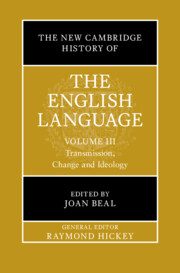Refine search
Actions for selected content:
169 results
2 - The Organization of the Mental Grammar
- from Part I - Introduction
-
- Book:
- Genes, Brains, Evolution and Language
- Published online:
- 13 November 2025
- Print publication:
- 13 November 2025, pp 17-76
-
- Chapter
- Export citation

The New Cambridge History of the English Language
- Transmission, Change and Ideology
-
- Published online:
- 23 October 2025
- Print publication:
- 23 October 2025

How to Create a Language
- The Conlang Guide
-
- Published online:
- 23 October 2025
- Print publication:
- 02 October 2025
-
- Textbook
- Export citation
9 - The Emerging Phonological Standard
- from Part II - Tracking Change in the History of English
-
-
- Book:
- The New Cambridge History of the English Language
- Published online:
- 23 October 2025
- Print publication:
- 23 October 2025, pp 246-270
-
- Chapter
- Export citation
14 - Beowulf as a Source Text for Archaic Features
- from Part II - Lighthouse Works and Authors
-
-
- Book:
- The New Cambridge History of the English Language
- Published online:
- 18 October 2025
- Print publication:
- 16 October 2025, pp 359-370
-
- Chapter
- Export citation
5 - Phonological Shifts
- from Part I - Building Words
-
- Book:
- How to Create a Language
- Published online:
- 23 October 2025
- Print publication:
- 02 October 2025, pp 80-105
-
- Chapter
- Export citation
Chapter 1 - Sounds of Language
-
- Book:
- English Phonetics and Phonology
- Published online:
- 17 October 2025
- Print publication:
- 10 July 2025, pp 1-14
-
- Chapter
- Export citation
4 - The Acquisition of Scottish Gaelic Phonology
- from Part II - Acquisition of Phonology and Phonetics
-
-
- Book:
- The Acquisition of Celtic Languages
- Published online:
- 03 July 2025
- Print publication:
- 10 July 2025, pp 69-89
-
- Chapter
- Export citation
5 - Acquisition of Irish Phonology
- from Part II - Acquisition of Phonology and Phonetics
-
-
- Book:
- The Acquisition of Celtic Languages
- Published online:
- 03 July 2025
- Print publication:
- 10 July 2025, pp 90-108
-
- Chapter
- Export citation

The Acquisition of Celtic Languages
-
- Published online:
- 03 July 2025
- Print publication:
- 10 July 2025
4 - How Do Children Learn Language?
- from Section I - The Early Years
-
- Book:
- Child Development
- Published online:
- 19 June 2025
- Print publication:
- 12 June 2025, pp 51-66
-
- Chapter
- Export citation
3 - Theoretical Background
-
- Book:
- Phonological Drift and Language Contact
- Published online:
- 17 June 2025
- Print publication:
- 05 June 2025, pp 31-58
-
- Chapter
- Export citation
The Bavadi and Their Bakhtiari Dialect
-
- Journal:
- Iranian Studies / Volume 58 / Issue 3 / July 2025
- Published online by Cambridge University Press:
- 19 May 2025, pp. 548-594
- Print publication:
- July 2025
-
- Article
-
- You have access
- Open access
- HTML
- Export citation
Raised and in-situ preverbal foci: A unified prosodic account
-
- Journal:
- Journal of Linguistics , First View
- Published online by Cambridge University Press:
- 28 April 2025, pp. 1-34
-
- Article
-
- You have access
- Open access
- HTML
- Export citation
1 - Noise and Timing
-
- Book:
- Stress and Accent
- Published online:
- 15 March 2025
- Print publication:
- 27 March 2025, pp 1-33
-
- Chapter
-
- You have access
- Export citation
9 - Summary and Conclusion
-
- Book:
- Stress and Accent
- Published online:
- 15 March 2025
- Print publication:
- 27 March 2025, pp 297-310
-
- Chapter
- Export citation

Stress and Accent
-
- Published online:
- 15 March 2025
- Print publication:
- 27 March 2025
The performance of L2 French children on the LITMUS-QU Nonword repetition task during their first year of exposure: impact of age, vocabulary size, verbal-short term memory and phonological awareness
-
- Journal:
- Bilingualism: Language and Cognition / Volume 28 / Issue 4 / August 2025
- Published online by Cambridge University Press:
- 27 January 2025, pp. 1015-1029
-
- Article
-
- You have access
- Open access
- HTML
- Export citation

German Phonology
- An Optimality-Theoretic Approach
-
- Published online:
- 04 January 2025
- Print publication:
- 09 January 2025
10 - False Memories: Spreading Activation in Memory Networks
- from Part III - Mind
-
- Book:
- Behavioral Network Science
- Published online:
- 08 November 2024
- Print publication:
- 19 December 2024, pp 143-160
-
- Chapter
- Export citation
